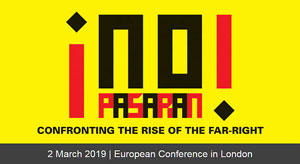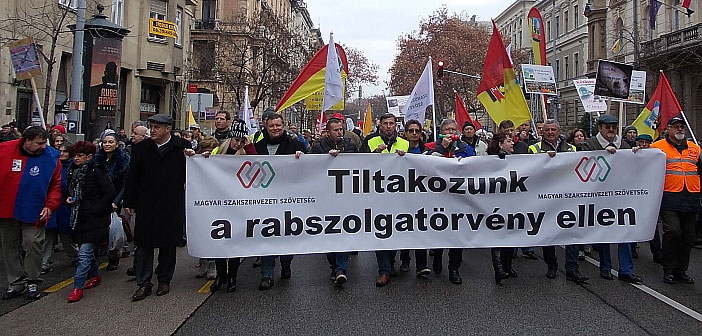Source: Transform! Europe / 21 December 2018
The most militant protests in Hungary for over a decade, with dozens arrested: the majority of protesters are young people under the age of thirty.
Shortly after the vote on Wednesday late night, around two thousand people, shouting “Orbán go to hell” marched through Budapest and converged on the steps of the parliament. Some protesters hurled objects at police, who responded with pepper spray and tear gas. Thirty five demonstrators were arrested.
Since 12 December, there have been demonstrations every day, and not only in Budapest, but in Pécs, Győr, Békéscsaba, and in other towns. On 13 December the Budapest rally was organized by the Students’ trade union and the Free University Group. Gáspár Miklós Tamás, a well-known Hungarian philosopher stated that students and workers have not demonstrated together in Hungary for a very long time.
On Saturday 15 December the anti-government demonstration started in the centre of Budapest at the Heroes Square, and continued on Kossuth Square in front of the parliament building. On Sunday night a spontaneous mass demonstration took place, marching about 5.5 km from the parliament to the state television, with red flags in the first row.
The protesters were led by two independent opposition politicians, both formerly co-chairs, but now expelled, from the green Politics Can be Different party (Lehet Más a Politika -LMP). They were due to read a petition on television, consisting of five points, but were refused permission. The list of five demands included, the immediate withdrawal of the “slave law”, less police overtime, joining the European Prosecutor`s Office, an independent judiciary and an independent public media. Several opposition MPs – both leftists and right-wingers – used their immunity to enter the building and spend the night there.
In the Hungarian context to demonstrate at the public media building has got historical background. On 15 March 1848, when a new revolutionary wave swept across Europe, the radicals of Pest[i] formulated the “Twelve Points” and their demands included, freedom of press. In October 1956 the revolutionaries wanted to read their demands in the Radio building, which is where the shooting started. The building of the state TV headquarters played an important role at the time of systemic change at the end of 1980s.
In Hungary the public media buildings have an outstanding relevance in the revolutionary process. In October 2006 when the Socialists were in power and Orbán’s Fidesz party was in opposition, the TV building, then located in the heart of Budapest, was attacked and set on fire by a right-wing mob. Shortly after, the headquarters of the public TV channel was moved from the centre to the outer district of Budapest to organize mass demonstrations more difficult.
Practically all public media – newspapers, radio stations, public and commercial TV channels – have been sold to Orbán’s childhood friend, the oligarch Lőrinc Mészáros. More than 200 newspapers are owned by mainly Mészáros’s Mediaworks. Only two TV channels – RTL Klub and ATV – and one radio station, Klubrádió, and one newspaper, Népszava, remain as public media, but Orbán is trying to take control over these too. The media are widely considered as “lies factory”, either distorting or silencing the real news. Regretfully, the Hungarian public has accepted with resignation that media is inaccessible, and that today a flood of lies are prevails in Hungary.
Monday morning armed security guards threw two MPs violently out of the state TV building. During the day, other opposition MPs, namely from: Liberal Socialist Democratic Coalition (Demokratikus Koalició – DK), Dialogue (Párbeszéd), MSZP, LMP, the extreme right Jobbik. stepped through the fence of the public TV headquarters to get in touch with their colleagues. One MP, László Varjú of DK was driven away in an ambulance car later on Monday after sustaining minor injuries in a tussle with the security guards. After the working hours demonstrations flared up again at the public TV building located now in the outskirts of Budapest.
The protests today entered their tenth day and has never been so violent since Fidesz came back to power in 2010. The protests are led by the up till now divided trade unions, opposition parties and students, who are outraged at reforms introduced by the ruling party. The demonstrations keep going continuously and every night, on average 30-50 people are arrested daily after clashes with the police who use tear gas.
The opposition politics radically changed over a week, and we are in the process of more radicalization. Protests in the past week have been the most violent in Hungary for over a decade with dozens arrested and at least fourteen police injured. The majority of the protesters are young people under age of thirty.
 Representatives of the new student movement, Szabad Egyetem, will be joining the NO PASARAN: Confronting the Rise of the Far-Right conference in London on 2 March 2019.
Representatives of the new student movement, Szabad Egyetem, will be joining the NO PASARAN: Confronting the Rise of the Far-Right conference in London on 2 March 2019.

